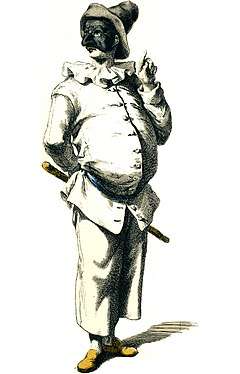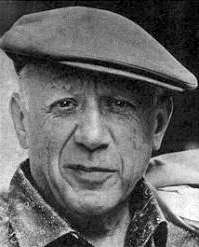Pulcinella (ballet)
| Pulcinella | |
|---|---|
 Pulcinella (Maurice Sand) | |
| Choreographer | Léonide Massine |
| Music | Igor Stravinsky |
| Based on | An 18th-century play |
| Premiere |
15 May 1920 Paris |
| Original ballet company | Ballets Russes |
| Characters |
Pulcinella Pimpinella Furbo Prudenza Rosetta Florindo Cloviello |
| Genre | Neoclassical ballet |
| Type | Classical ballet |
Pulcinella is a one-act neoclassical ballet by Igor Stravinsky based on an 18th-century play Quartre Polichinelles semblables ("Four identical Pulcinellas"). Pulcinella is a stock character originating from commedia dell'arte.
The ballet premiered at the Paris Opera on 15 May 1920 under the baton of Ernest Ansermet. The dancer Léonide Massine created both the libretto and choreography, and Pablo Picasso designed the original costumes and sets. The ballet was commissioned by Sergei Diaghilev.
A performance of the work typically lasts 35 minutes. The ballet score was revised by Stravinsky in 1965.
History
Diaghilev wanted a ballet based on an early eighteenth-century commedia dell'arte libretto and music then believed to have been composed by Giovanni Battista Pergolesi. Although the music was then attributed to Pergolesi, much of that attribution has since proved to be spurious;[1] some of the music may have been written by Domenico Gallo, Unico Wilhelm van Wassenaer, Carlo Ignazio Monza, and possibly Alessandro Parisotti.
Conductor Ernest Ansermet wrote to Stravinsky in 1919 about the prospect, but the composer initially did not like the idea of music by Pergolesi. However, once he studied the scores, which Diaghilev had found in libraries in Naples and London, he changed his mind. Stravinsky rewrote this older music in a more modern way by borrowing specific themes and textures but interjecting modern rhythms, cadences, and harmonies.
Pulcinella marked the beginning to Stravinsky's second phase as a composer, his neoclassical period. Stravinsky wrote that "Pulcinella was my discovery of the past, the epiphany through which the whole of my late work became possible. It was a backward look, of course—the first of many love affairs in that direction—but it was a look in the mirror, too."[2]
The ballet was revived and revised by New York City Ballet's balletmasters George Balanchine and Jerome Robbins, who both danced, Robbins in the title role, for their 1972 Stravinsky Festival. They were joined in the premier by Francisco Moncion who danced the role of The Devil.[3]
Story
The story of Pulcinella is taken from a manuscript from Naples, dating from 1700, containing a number of comedies portraying the traditional character of the popular Neapolitan stage. The particular story used is entitled Quartre Polichinelles semblables ("Four identical Pulcinellas").
The one-act ballet features Pulcinella, his girlfriend Pimpinella, his friends Furbo, Prudenza and Rosetta, and Florindo and Cloviello. The story starts with Florindo and Cloviello serenading Prudenza and Rosetta. The two women are unimpressed and reply by showering the suitors with water. Prudenza's father, a doctor, appears and chases them away.
A new episode begins with Rosetta with her father appearing. Rosetta dances for Pulcinella and they kiss. But Pimpinella sees this and interrupts the scene. Florindo and Cloviello arrive and jealous of Pulcinella, they beat him up. Pulcinella is then stabbed, but this is actually a mockery to get Pimpinella to forgive Pulcinella. Furbo disguised as a magician appears and resurrects Pulcinella's body in front of everybody. Pimpinella indeed forgives Pulcinella, Prudenza and Rosetta succumb to Florindo's and Cloviello's wooing. The ballet ends with the marriages of the couples.
Music
Instrumentation
Pulcinella is scored for a modern chamber orchestra with three solo singers:
Form
The ballet is in one act and is divided into 20 sections:
- Overture: Allegro moderato
- Serenata: Larghetto: "Mentre l'erbetta" (tenor)
- Scherzino: Allegro
- Allegro
- Andantino
- Allegro
- Ancora poco meno: "Contento forse vivere" (soprano)
- Allegro assai
- Allegro – alla breve: "Con queste paroline" (bass)
- Andante: "Sento dire no'ncè pace" (soprano, tenor and bass)
- Allegro: "Ncè sta quaccuna po" (soprano and tenor)
- Presto: "Una te fallan zemprecce" (tenor)
- Allegro – Alla breve
- Tarantella
- Andantino: "Se tu m'ami" (soprano)
- Allegro
- Gavotta con due variazioni
- Vivo
- Tempo di minuetto: "Pupillette, fiammette d'amore" (soprano, tenor and bass)
- Finale: Allegro assai
Pieces based on Pulcinella
Pulcinella Suite
The Pulcinella Suite, derived from the ballet, was written in 1922 and has no vocal parts. The first performance was in Boston, with the Boston Symphony Orchestra and Pierre Monteux on 22 December 1922.
The suite consists of eight movements:
- Sinfonia
- Serenata
- Scherzino – Allegretto – Andantino
- Tarantella
- Toccata
- Gavotta (con due variazioni)
- Vivo
- Minuetto – Finale
The suite was revised by the composer in 1949 and 1965.
Suite italienne
Stravinsky also based the following works on the ballet:
- 1925: Suite d'après des thèmes, fragments et morceaux de Giambattista Pergolesi for violin and piano (in collaboration with Paul Kochanski).
- 1932/33: Suite italienne for cello and piano (in collaboration with Gregor Piatigorsky).
- 1933: Suite italienne for violin and piano (in collaboration with Samuel Dushkin).
- Somewhat later, Jascha Heifetz and Piatigorsky made an arrangement for violin and cello, which they also called Suite italienne.
Notes
- ↑ Dunning 1988.
- ↑ Saint Louis Symphony Program Notes, in External Links
- ↑ Francisco Moncion as The Devil in the premier of Balanchine's "Pulcinella" The George Balanchine Foundation - "Pulcinella" - Francisco Moncion on balanchine.org
Sources
- Dunning, Albert (1988). "Un gentilhomme hollandais, diplomate-compositeur, à la cour de Louis XV: Nouvellesrecherches sur le comte Unico Wilhelm van Wassenaer". Revue de Musicologie 74, no. 1:27–51.
- White, Eric Walter (1966). Stravinsky: The Composer and His Works, second edition. Berkeley: University of California Press. ISBN 978-0-520-03983-4.
External links
- Programme notes
- Source for the composers, on whose music Stravinsky based the score
